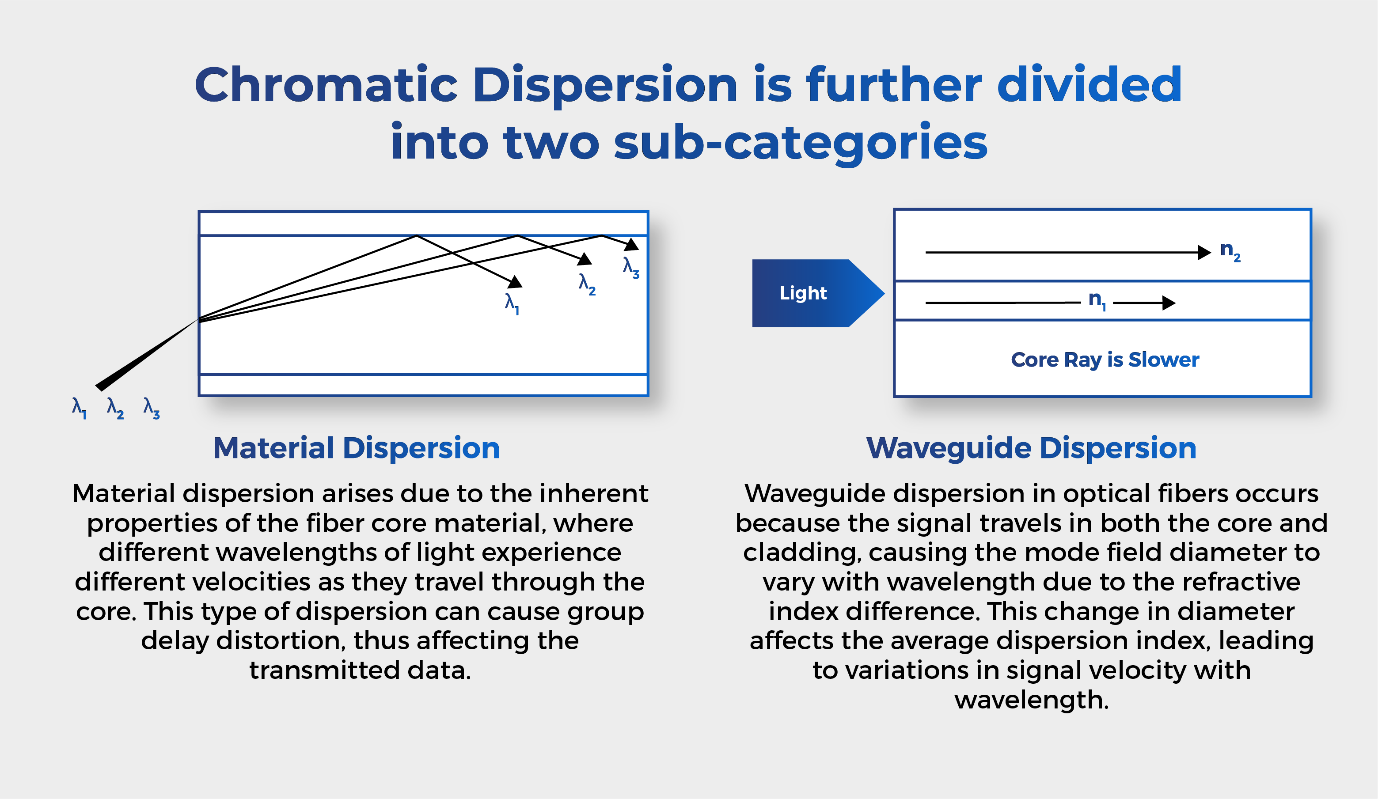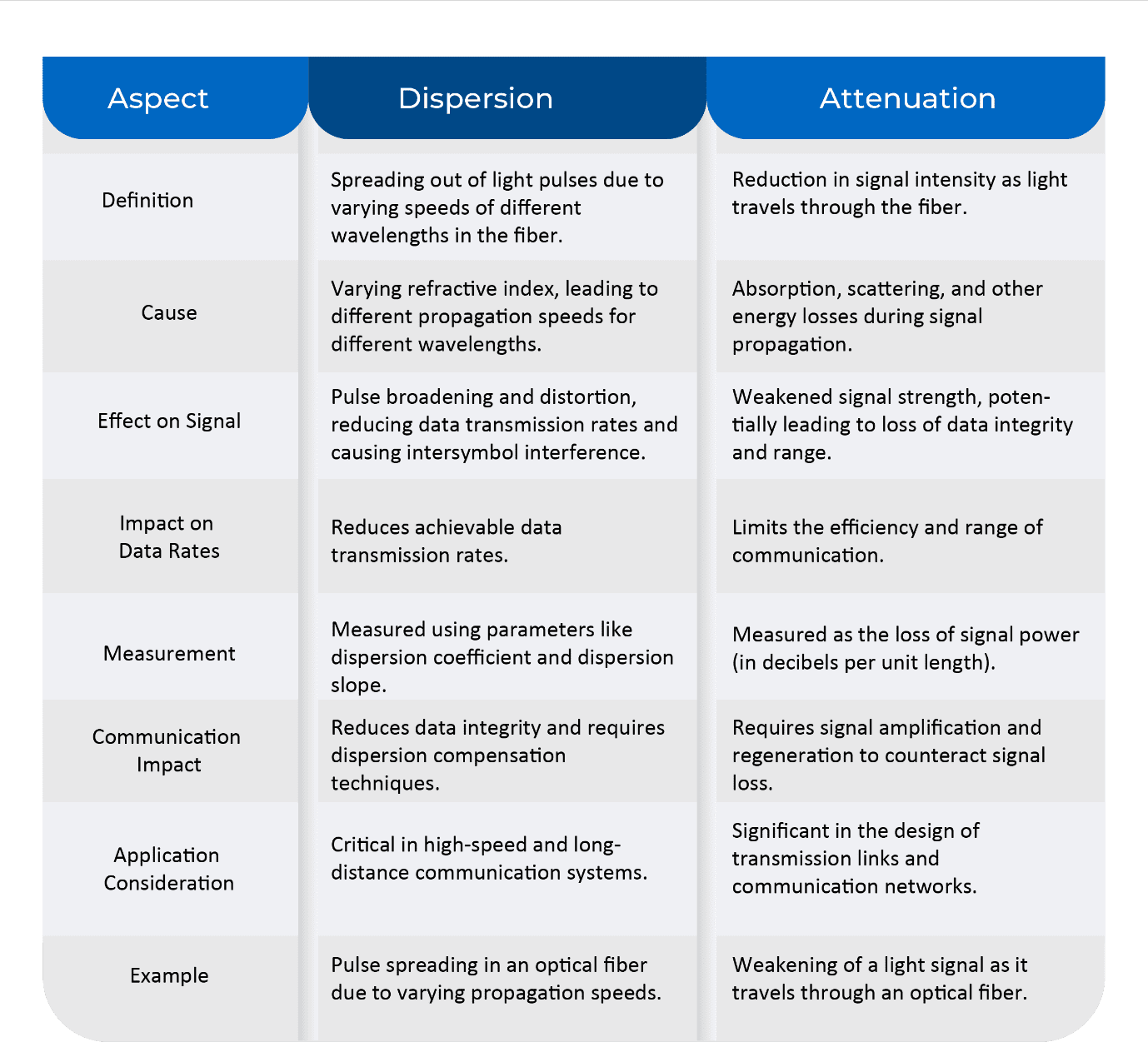Imagine writing a sentence, but the letters get jumbled up. This makes it harder for the receiver to read and interpret the message correctly. In the same way, dispersion in optical fiber can cause the signals to overlap and interfere with each other, making it challenging for the receiver to understand the original message. Today, we will learn in detail about dispersion, its types, and its effects on optical fiber communication.
Dispersion Explained- In Simple and Technical Terms
In simple terms, dispersion is a phenomenon where different colors or components of a wave travel at different speeds through a material, causing the wave to spread out or separate.
Think of it like this: Imagine a beam of white light passing through a glass prism. Instead of staying together as white light, the light splits into a rainbow of colors. This happens because each color travels at a slightly different speed inside the glass. This separation of colors is what we call dispersion.
Dispersion doesn't just happen with light; it can also occur with other types of waves, like sound waves or radio waves. When waves disperse, their different components move through the material at varying speeds, leading to interesting effects and colorful displays, like the rainbow produced by a prism.
In technical terms, dispersion in optical fiber refers to the phenomenon where different wavelengths of light experience varying velocities as they travel through the fiber. It causes pulses of light to spread out over time, leading to signal degradation and limiting the transmission capacity of the fiber. There are different types of dispersion in optical fibers, let’s understand them one by one.
Types of Dispersion in Optical Fiber
Generally, there are three main types of dispersions in a fiber:
Chromatic Dispersion:
This type of dispersion is caused by the spectral width of the light emitted from the transmitter (e.g., LED or laser) used in optical fiber communication. The spectral width determines the range of different wavelengths emitted. The longer wavelengths typically travel faster than the shorter ones, causing light pulses to broaden and overlap, reducing the achievable data rate.
To understand this better, consider a scenario where multiple light pulses of different wavelengths are transmitted through an optical fiber. Over a long distance, chromatic dispersion causes the pulses to spread out, making it challenging to distinguish individual bits of information.

Types of Chromatic Dispersion
Modal Dispersion:
Modal dispersion arises in multimode fibers, where light can take multiple paths or modes as it propagates through the fiber. Each mode follows a distinct path and experiences different propagation times, leading to pulse spreading. Modal dispersion becomes more pronounced in fibers with larger core diameters, reducing their capacity to transmit data accurately.
For example, in a step-index multimode fiber, light traveling at different angles experiences varied path lengths, causing the pulses to spread out and degrade over long distances. This issue becomes increasingly significant at higher data rates, limiting the fiber's ability to support modern high-speed communication systems.
Polarization Mode Dispersion:
Polarization Mode Dispersion (PMD) is an optical issue in fiber-optic communication. When light travels through the fiber, it consists of two polarization states: horizontal and vertical. In a perfect scenario, both states would travel at the same speed, and data transmission would be seamless. However, imperfections in the fiber cause the polarization modes to travel at slightly different speeds. This leads to a time difference between the two components, causing the light pulse to spread out and arrive distorted at the receiver. As a result, data can get corrupted, reducing the signal quality and data transmission rates.
To manage PMD, fiber-optic systems are designed with carefully selected materials and components that compensate for the differential delays. While these measures help, PMD can still be a concern in long-distance and high-data-rate applications, requiring constant improvements in fiber-optic technology to ensure reliable communication.
Effects of dispersion on optical fiber communication:
When we talk about modern communication systems, optical fibers play a pivotal role in facilitating high-speed data transmission over long distances. The ability to carry vast amounts of data efficiently and reliably is critical for a wide array of applications, including telecommunications, data centers, and the Internet. However, as data rates and transmission distances increase, so do the challenges in maintaining signal integrity. One of the primary factors that affect signal quality in optical fibers is dispersion. Other than that, there are other key effects of dispersion on communication which are as follows:
Pulse Broadening:
As light signals travel through an optical fiber, dispersion causes different wavelengths to travel at different speeds, leading to pulse broadening. This spreading out of the pulses in time can cause overlapping and intersymbol interference, making it challenging for the receiver to distinguish between different bits or symbols in the data stream.
Reduced Data Rates:
Pulse broadening limits the achievable data transmission rates in optical fiber communication. Higher dispersion leads to more severe pulse spreading, necessitating lower data rates to maintain reliable communication and minimize errors.
Signal Distortion:
Dispersion can distort the original shape of light pulses, resulting in signal degradation. This distortion can cause errors in data transmission, leading to the need for error correction techniques or retransmissions, reducing overall system efficiency.
Limited Transmission Distance:
In long-distance fiber-optic links, dispersion becomes more pronounced as the signals propagate over greater distances. At some point, the accumulated dispersion can become too significant to maintain reliable communication, imposing limitations on the transmission distance.
Wavelength Division Multiplexing (WDM) Challenges:
In Wavelength Division Multiplexing systems, where multiple wavelengths are used to transmit data simultaneously, dispersion can introduce varying delays among different channels, requiring additional dispersion compensation techniques.
Dispersion vs Attenuation:

Attenuation vs. Dispersion in Optical Fiber
How to combat dispersion in optical fibers?
To reduce the detrimental effects of dispersion in optical fibers, various dispersion compensation techniques have been developed. The two primary approaches are dispersion-shifted fibers and dispersion-compensating fibers. Dispersion-shifted fibers are engineered to reduce the effects of chromatic dispersion by altering the fiber's dispersion profile, pushing the zero-dispersion wavelength to longer wavelengths where chromatic dispersion is less pronounced. Dispersion-compensating fibers, on the other hand, are designed to have opposite dispersion characteristics to the main transmission fiber, enabling effective compensation of dispersion.
Final Words:
Dispersion is a crucial aspect to consider in optical fiber communication systems, as it directly impacts data transmission quality and capacity. By understanding the different types of dispersion and their effects on signal propagation, engineers can design and optimize optical fiber networks to achieve higher data rates and longer transmission distances. As technology continues to advance, research and innovation in dispersion compensation techniques will play a vital role in improving optical fiber communication and meeting the ever-increasing demands for faster and more reliable data transmission.